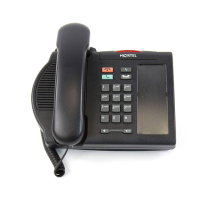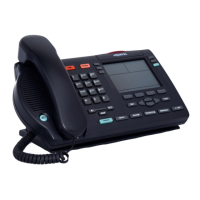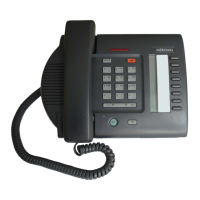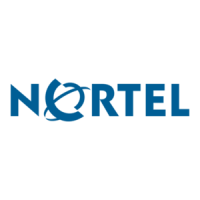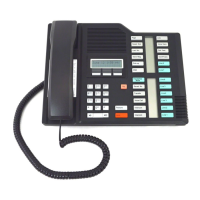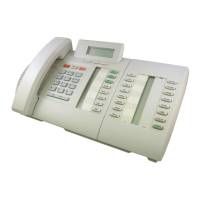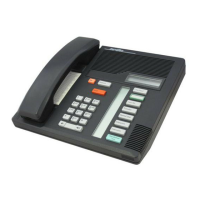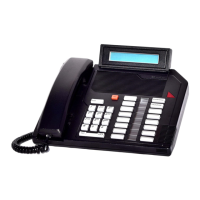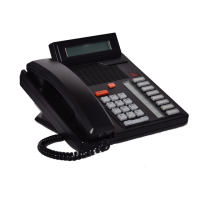Do you have a question about the Nortel M3905 and is the answer not in the manual?
Diagram and overview of the M3905 Call Center telephone components.
Details on the telephone's programmable, soft, and fixed feature keys.
Explanation of the telephone's physical keys like Hold, Mute, Goodbye.
Details on specific ACD function keys like In-Calls, Headset, Supervisor, Emergency.
Definitions of key terms related to directory numbers and extensions.
Explanation of the telephone's display layout and information shown.
Procedure to change the telephone's display language.
How to customize the labels on programmable feature keys.
Procedure to adjust the display's contrast level.
How to adjust the ringer and other audio volumes.
How to select from available ringing sounds.
Enabling the feature to access dial tone by pressing any dial pad key.
Configuring area codes to improve local and internal call identification.
Activating the feature to measure call duration.
Selecting the appropriate headset type for optimal performance.
Testing the telephone's display screen and indicator lights.
How to switch between headset and handset modes.
Procedure for agents to log into the Automatic Call Distribution (ACD) queue.
Detailed login procedure using Agent ID and MQA for queue assignment.
Steps to correct mistakes made during the agent login process.
How to use default login settings for convenience.
Recording and managing agent activities using activity codes.
How to answer incoming calls from the ACD queue.
Procedure for initiating an emergency call.
Setting agent status to 'Not Ready' for post-call work.
Handling calls that are not part of the ACD queue.
Procedures for agents to contact their supervisor.
Functionality for temporarily leaving the desk during calls.
Understanding the supervisor's keys for monitoring agent status.
How a supervisor answers a call initiated by an agent.
How a supervisor initiates a call to an agent.
How a supervisor monitors an agent's call.
Automatic call routing based on queue waiting times.
Features and procedures for after-hours telephone service.
Understanding the visual indicators for ACD queue status.
Accessing and viewing information about the ACD queue.
Supervisor view showing the status of agent positions.
General instructions and methods for making calls.
Previewing and correcting numbers before dialing.
Speed dialing by pressing a dedicated Auto Dial key.
Automatically redialing a number when busy or unanswered.
Speed dialing using one, two, or three-digit codes.
Making internal calls to specific users or groups.
Temporarily suspending an active call.
Redirecting an active call to a third party.
Receiving a reminder tone for unanswered transferred calls.
Temporarily holding calls to be retrieved from any phone.
Procedure for tracing nuisance or malicious calls.
Automatically answering incoming calls in handsfree mode.
Answering calls from other extensions within a pickup group.
Managing multiple incoming calls while on an existing call.
Redirecting incoming calls to another telephone number.
Forwarding only calls originating from internal extensions.
Forwarding calls to another phone from a remote location.
Creating multi-party calls for group discussions.
Connecting to an existing call to form a conference.
Calling a predefined group of users sequentially.
Signaling another phone with a brief audible buzz.
Making announcements over the paging system.
Charging calls to a specific account or forcing charges.
Overriding busy signals to initiate a call or conference.
Automatically connecting to a line that becomes free.
Using the system's radio paging functionality.
Making voice announcements to another user.
Controlling voice messaging system features via soft keys.
Navigating through call logs and personal contact directories.
Securing directory and call log information with a password.
Viewing and managing the list of incoming calls.
Viewing and managing the list of outgoing calls.
Opening and navigating the personal contact directory.
Adding new contacts with names and numbers.
Saving details of an incoming call to the directory.
Saving details of an outgoing call to the directory.
Managing existing contacts by deleting or editing them.
Initiating calls directly from the personal directory.
Finding specific contacts within the personal directory.
Enabling and using the quick visual messaging feature.
Customizing or creating new quick messages.
Searching and using the company contact directory.
Description of the module for connecting various accessories.
Details on optional key cap kits for customizing phone buttons.
Connecting analog devices like modems or fax machines.
Information on headset compatibility and selection.
PC software for managing the telephone's personal directory.
Diagram and overview of the M3905 Call Center telephone components.
Details on the telephone's programmable, soft, and fixed feature keys.
Explanation of the telephone's physical keys like Hold, Mute, Goodbye.
Details on specific ACD function keys like In-Calls, Headset, Supervisor, Emergency.
Definitions of key terms related to directory numbers and extensions.
Explanation of the telephone's display layout and information shown.
Procedure to change the telephone's display language.
How to customize the labels on programmable feature keys.
Procedure to adjust the display's contrast level.
How to adjust the ringer and other audio volumes.
How to select from available ringing sounds.
Enabling the feature to access dial tone by pressing any dial pad key.
Configuring area codes to improve local and internal call identification.
Activating the feature to measure call duration.
Selecting the appropriate headset type for optimal performance.
Testing the telephone's display screen and indicator lights.
How to switch between headset and handset modes.
Procedure for agents to log into the Automatic Call Distribution (ACD) queue.
Detailed login procedure using Agent ID and MQA for queue assignment.
Steps to correct mistakes made during the agent login process.
How to use default login settings for convenience.
Recording and managing agent activities using activity codes.
How to answer incoming calls from the ACD queue.
Procedure for initiating an emergency call.
Setting agent status to 'Not Ready' for post-call work.
Handling calls that are not part of the ACD queue.
Procedures for agents to contact their supervisor.
Functionality for temporarily leaving the desk during calls.
Understanding the supervisor's keys for monitoring agent status.
How a supervisor answers a call initiated by an agent.
How a supervisor initiates a call to an agent.
How a supervisor monitors an agent's call.
Automatic call routing based on queue waiting times.
Features and procedures for after-hours telephone service.
Understanding the visual indicators for ACD queue status.
Accessing and viewing information about the ACD queue.
Supervisor view showing the status of agent positions.
General instructions and methods for making calls.
Previewing and correcting numbers before dialing.
Speed dialing by pressing a dedicated Auto Dial key.
Automatically redialing a number when busy or unanswered.
Speed dialing using one, two, or three-digit codes.
Making internal calls to specific users or groups.
Temporarily suspending an active call.
Redirecting an active call to a third party.
Receiving a reminder tone for unanswered transferred calls.
Temporarily holding calls to be retrieved from any phone.
Procedure for tracing nuisance or malicious calls.
Automatically answering incoming calls in handsfree mode.
Answering calls from other extensions within a pickup group.
Managing multiple incoming calls while on an existing call.
Redirecting incoming calls to another telephone number.
Forwarding only calls originating from internal extensions.
Forwarding calls to another phone from a remote location.
Creating multi-party calls for group discussions.
Connecting to an existing call to form a conference.
Calling a predefined group of users sequentially.
Signaling another phone with a brief audible buzz.
Making announcements over the paging system.
Charging calls to a specific account or forcing charges.
Overriding busy signals to initiate a call or conference.
Automatically connecting to a line that becomes free.
Using the system's radio paging functionality.
Making voice announcements to another user.
Controlling voice messaging system features via soft keys.
Navigating through call logs and personal contact directories.
Securing directory and call log information with a password.
Viewing and managing the list of incoming calls.
Viewing and managing the list of outgoing calls.
Opening and navigating the personal contact directory.
Adding new contacts with names and numbers.
Saving details of an incoming call to the directory.
Saving details of an outgoing call to the directory.
Managing existing contacts by deleting or editing them.
Initiating calls directly from the personal directory.
Finding specific contacts within the personal directory.
Enabling and using the quick visual messaging feature.
Customizing or creating new quick messages.
Searching and using the company contact directory.
Description of the module for connecting various accessories.
Details on optional key cap kits for customizing phone buttons.
Connecting analog devices like modems or fax machines.
Information on headset compatibility and selection.
PC software for managing the telephone's personal directory.
